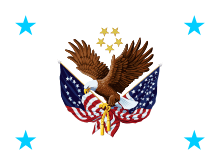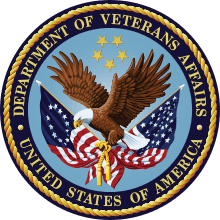Board of Veterans' Appeals
 | |
 Flag of the Chairman of the Board of Veterans' Appeals and Assistant Secretary of Veterans' Affairs | |
| Agency overview | |
|---|---|
| Formed |
July 21, 1930 (Cabinet rank 15 March 1989) |
| Preceding agency |
|
| Jurisdiction | United States federal government |
| Headquarters |
810 Vermont Avenue NW., Washington, D.C., U.S. 38°54′3.25″N 77°2′5.36″W / 38.9009028°N 77.0348222°WCoordinates: 38°54′3.25″N 77°2′5.36″W / 38.9009028°N 77.0348222°W |
| Employees | 312,841 (2013) |
| Annual budget | $78.4 billion (2013) |
| Agency executives | |
| Child agency |
|
| Website | www.VA.gov |
The Board of Veterans' Appeals (often referred to as the Board) is an administrative tribunal within the United States Department of Veterans Affairs (VA), located in Washington, D.C. It determines whether U.S. military veterans are entitled to claimed veterans' benefits. The Board's mission is to conduct hearings and decide appeals properly before the Board in a timely manner. 38 United States Code (U.S.C.) § 7101 (a). The Board's jurisdiction extends to all questions in matters involving a decision by the Secretary under a law that affects a provision of benefits by the Secretary to Veterans, their dependents, or their Survivors. 38 U.S.C. §§ 551(a); 7104(a). Final decision on such appeals are made by the Board based on the entire record in the proceedings and upon consideration of all evidence and applicable provisions of law and regulation.[1] The Board's review is de novo.
The Board is lead by the Chairman of the Board of Veterans' Appeals.[2] The Chairman is nominated by the President and confirmed by the Senate. The Chairman position was vacant from February 2011 - December 2017. On September 5, 2017, President Donald J. Trump nominated Cheryl L. Mason of Virginia to be Chairman of the Board of Veterans Appeals for a term of six years.[3] Chairman Mason was sworn in a ceremony at the Board of Veterans' Appeals by Dr. David J. Shulkin[4], the Secretary of Veterans Affairs, on 15 December 2017.
In Fiscal Year 2018, the Board issued over 81,000 decisions[5] for Veterans and their families, which is the highest number of decisions issued by the Board since the 1988 enactment of the Veterans' Judicial Review Act (VJRA), which established the United States Court of Appeals for Veterans Claims (CAVC). Additionally, the Board held 16,423 hearings.
Appeals Process
The appeals process in the Department of Veterans Affairs (VA of the Department) is a complex, non-linear process, which is set in law and is unique from other standard appeals processes across the Federal and judicial systems. A feature of the current VA appeals process is a continuous open record that allows a Veteran, Survivor, or other appellant to submit new evidence and/or make new argument at any point from the beginning to the end of the appeals process. Additionally, the duty to assist throughout the appeals process requires VA to develop further evidence on the Veteran's behalf and pursue new argument and theories of entitlement. Each time arguments are presented and evidence is added/ obtained, VA generally must issue another decision considering that evidence, which protracts the timeline for appellate resolution.[1]
In Fiscal Year 2015, the Board received and docketed 69,957 appeals[6] and anticipated the docketing of 88,183 claims in the 2016 fiscal year.[7] The Board's cycle time, which measures the average time from the date an appeal is certified to the Board (VA Form 9) until a decision is dispatched was 160 days in Fiscal Year 2015 (excluding the time the case is with a Veterans Service Organization (VSO), such as Disabled American Veterans (DAV), American Legion (AL), or Veterans of Foreign Wars (VFW) for review and submission of written argument).[8]
Due to increasing difficulty to address the growing number of appeals in the current system, there have been various attempts to streamline the appeals process. As of 2017, the most recent proposal was the Department of Veterans Affairs Appeals Modernization Act, a reintroduction of S. 3328 from the 114th U.S. Congress. The bill was reintroduced on March 24, 2017 by a group of sixteen U.S. Senators, which include original cosponsors of the legislation.[9]
History
The Board of Veterans Appeals was established in July 1933.[10] It was given authority to hear appeals on benefit decisions.[10] Members are appointed by the Secretary of Veterans Affairs with the approval of the President of the United States.[10]
Background of Veteran's Benefits
During ancient times, compensation for veterans was often in the form of land and goods that were seized from the enemy. This allowed rulers and commanders to win over loyalty of soldiers who may otherwise turn on them. Veterans benefits evolved in the West during the decline of the feudal system and the subsequent rise of modern Nation States. Personal fealty in the feudal system was replaced with benefits suitable to sustain national armies. Furthermore, the act of compensating and caring for soldiers with disabilities incurred in battle also began in ancient times and has since evolved into the systems we see today. In Greek city states, for example, benefits were given to disabled soldiers and to orphans of soldiers killed in battle.[11] The act of caring for veterans in this regard has changed little since that time. This belief is also reflected in U.S. President Abraham Lincoln's words "to care for him who shall have borne the battle and for this widow, and his orphan," which is also the current motto of the United States Department of Veterans Affairs.[12]
Evolution of the Appeals Process:[13]
- 1917– Current benefits system created for Veterans of World War I.
- 1933– Board of Veterans' Appeals created to provide appellate review.
- 1957– VA Adjudication Regulations enacted as statute.
- 1962– Statement of the Case and Substantive Appeals procedures added.
- 1988– Veterans' Judicial Review Act of 1988 adds Court of Appeals for Veterans Claims, Federal Circuit Court, and Supreme Court Review.
- 2000– Veterans Claims Assistance Act expands number of issues requiring remand.
- 2001– Decision Review Officer (DRO) added between Notice of Disagreement (NOD) and Substantive Appeal.
Membership
The Board has as many members as the Secretary of the Department of Veterans Affairs deems "necessary in order to conduct hearings and dispose of appeals properly before the Board in a timely manner".[14] Board members are appointed by the Secretary, with the approval of the President.[15] Members of the Board are also referred to as Veterans Law Judges.
As of the end of Fiscal Year 2015, the Board consisted of 63 members.[16] Members of the Board are required to be "experienced attorneys in the field of veterans law".[17] Staff attorneys, also trained in veterans law, review the facts of each appeal and assist the Board members.[18][19]
Chairman of the Board
The Chairman of the Board of Veterans' Appeals is a senior position within the United States Department of Veterans Affairs that directs the Board of Veterans' Appeals. The Chairman is nominated by the President and confirmed by the Senate for a 6-year term[20]
David Spickler, formerly the Principal Deputy Vice Chairman, served as the Executive-in-Charge from January 20, 2017 to December 10, 2017.
Cheryl L. Mason was nominated by President Donald Trump to become the Chairman of the Board on September 5, 2017[21] and was confirmed by the United States Senate on November 8, 2017.[22] Chairman Mason was sworn in by Secretary Shulkin on December 11, 2017.
List of Chairmen of the Board of Veterans' Appeals
The following individuals served as Chairman:
- John G. Pollard (1934–1937)
- Robert L. Jarnagin (1937–1957)
- James W. Stencil (1957–1971)
- Lawrence R. Pierce, Jr. (1971–1974)
- Sydney J. Shuman (1974–1981)
- Kenneth E. Eaton (1982–1991)
When Veterans' Affairs became a Cabinet Department, the Chairman position became a Presidential Appointment with Senate Confirmation to a 6-year term:
- Charles Cragin (March 1991 – March 1997)
- Eligah Dane Clark (November 1998 – November 2004)
- James P. Terry (July 2005 – February 2011)
- Cheryl L. Mason (December 2017 – Present)
Procedure
An individual may file a claim for VA Veterans benefits and programs, such as: Disability Compensation; Education Assistance (GI Bill/ Post 9-11 GI Bill); Insurance; Dependency and Indemnity Compensation; Medical; Pension; and Vocational Rehabilitation and Education (VR&E). The most common claim is for Disability Compensation, which comprised 93.88 percent of all appeals in Fiscal Year 2015.[23] For example, a Veteran who receives an injury, or develops a medical condition while serving in the United States Armed Forces, is generally entitled to receive compensation based on the degree to which the injury affects things like the person's mobility, future earning capacity, or quality of life. A claimant seeking such benefits first files a claim with a Regional Office of the VA located near the claimant. When a claimant's application for benefits has been denied by the Agency of Original Jurisdiction, such as the Veterans Benefits Administration (VBA), Veterans Health Administration (VHA) or National Cemetery Administration (NCA), an appeal can be made to the Board of Veterans' Appeals.[24] The Board is part of the Department of Veterans Affairs, located in Washington, DC, and makes the final determination on an appeal within the VA's jurisdiction. Board members make the final decision on appeals within the VA. The Board also employs staff attorneys that assist the Board members while preparing a decision for a claim, much like a clerk for a judge.[25]
Decisions of the Board may be appealed to the United States Court of Appeals for Veterans Claims,[26] which is not part of the Department of Veterans Affairs, and from there to the United States Court of Appeals for the Federal Circuit.[27]
Process of filing an appeal with the Board
The process of appealing an unfavorable decision consists of several steps:
- Step 1: If a Veteran disagrees with all of part of a VA decision, he or she must file a Notice of Disagreement (NOD). An NOD is filed on a VA Form 21-0958, which is available at http://www.vba.va.gov/pubs/forms/VBA-21-0958-ARE.pdf. A NOD must be filed one year from the date of the letter notifying the Veteran of the claims decision and must be filed on the standard form.
- Step 2: the local VA office will review the Veteran's file again, prepare a written explanation of why the claim was denied, known as the Statement of the Case (SOC), and provide a copy to the claimant by mail. If any evidence or request that VA obtain any evidence is submitted after the mailing of the Statement of the Case, the claimant may receive a Supplemental Statement of the Case (SSOC) after the local VA office reviews that evidence.
- Step 3: After reviewing the Statement of the Case (SOC), the Veteran (appellant), usually via his or her attorney, claims agent, or Veterans Service Officer, files a formal notice of appeal on a VA Form 9, Appeal to Board of Veterans' Appeals', which is available online at http://www.va.gov/vaforms/va/pdf/VA9.pdf. At this time, the appellant may elect an optional hearing before a Veterans Law Judge.
- Optional Step 4: If an optional in-person or video teleconference hearing with a Veterans Law Judge at the Board of Veterans’ Appeals is selected on the VA Form 9, the hearing will be scheduled at the appellant's local VA office (Regional Office). Central Office hearing requests in Washington, DC are scheduled by the Board. An appellant's travel costs for a hearing are not paid by VA.
- Step 5: After a Substantive Appeal (VA Form 9) is filed and hearing held (if applicable), the local VA office will certify and transfer the appeal to the Board of Veterans’ Appeals, where a decision will be prepared and mailed to the appellant.
A more detailed overview of the appeals process can be found in VA Pamphlet 01-15-02B, which is available online at https://www.bva.va.gov/How_Do_I_APPEAL.asp.
References
- 1 2 http://www.bva.va.gov/docs/Chairmans_Annual_Rpts/BVA2015AR.pdf

- ↑ http://www.bva.va.gov/
- ↑ https://www.congress.gov/nomination/115th-congress/932
- ↑ "David Shulkin", Wikipedia, 2018-10-03, retrieved 2018-10-12
- ↑ "VA achieves historic goal by delivering 81,000 appeals decisions to Veterans in fiscal 2018". VA News Release. September 14, 2018.
- ↑ BOARD OF VETERANS' APPEALS, REPORT OF THE CHAIRMAN: FISCAL YEAR 2015, page 29.http://www.bva.va.gov/docs/Chairmans_Annual_Rpts/BVA2015AR.pdf
- ↑ , citing BOARD OF VETERANS' APPEALS, REPORT OF THE CHAIRMAN: FISCAL YEAR 2015, page 23.
- ↑ BOARD OF VETERANS' APPEALS, REPORT OF THE CHAIRMAN: FISCAL YEAR 2015, page 5 .http://www.bva.va.gov/docs/Chairmans_Annual_Rpts/BVA2015AR.pdf
- ↑ https://www.kaine.senate.gov/press-releases/warner-and-kaine-introduce-legislation-to-overhaul-broken-va-appeals-process
- 1 2 3 United States Department of Veterans Affairs, VA History in Brief, p. 12.
- ↑ James D. Ridgway, George Washington University – Law School, April 30, 2010, Veterans L. Rev., Vol. 3, No. 135, 2011
- ↑ http://www.va.gov/opa/publications/celebrate/vamotto.pdf
- ↑ The Veterans Appeals Process, page 12. http://www.bva.va.gov/docs/Veterans-Appeals-Process-Briefing.pdf
- ↑ 38 U.S.C. § 7101(a).
- ↑ Daniel T. Shedd, "Overview of the Appeal Process for Veterans' Claims", Congressional Research Service Report 7-5700 (April 29, 2013), page 3, citing 38 U.S.C. §7101A.
- ↑ BOARD OF VETERANS' APPEALS, REPORT OF THE CHAIRMAN: FISCAL YEAR 2015, page 29 http://www.bva.va.gov/docs/Chairmans_Annual_Rpts/BVA2015AR.pdf
- ↑ Daniel T. Shedd, "Overview of the Appeal Process for Veterans' Claims", Congressional Research Service Report 7-5700 (April 29, 2013), page 3.
- ↑ Board of Veterans Appeals.
- ↑ 38 U.S.C. §§ 7103, 7104.
- ↑ 38 U.S.C. § 7101(b)(1).
- ↑ "Forty-Six Nominations Sent to the Senate Today". White House. September 5, 2017. Retrieved 9 November 2017.
- ↑ "PN932 — Cheryl L. Mason — Department of Veterans Affairs". U.S. Congress. November 8, 2017. Retrieved 9 November 2017.
- ↑ BOARD OF VETERANS APPEALS ANNUAL REPORT FY2015, Page 26. http://www.bva.va.gov/docs/Chairmans_Annual_Rpts/BVA2015AR.pdf
- ↑ Daniel T. Shedd, "Overview of the Appeal Process for Veterans' Claims", Congressional Research Service Report 7-5700 (April 29, 2013), page 3, citing 38 U.S.C. §7104(a).
- ↑ Daniel T. Shedd, "Overview of the Appeal Process for Veterans' Claims", Congressional Research Service Report 7-5700 (April 29, 2013), page 3, citing BOARD OF VETERANS' APPEALS, VAPAMPHLET 01-00-1, UNDERSTANDING THE APPEALS PROCESS (2000), page 6.
- ↑ Daniel T. Shedd, "Overview of the Appeal Process for Veterans' Claims", Congressional Research Service Report 7-5700 (April 29, 2013), page 3, citing 38 U.S.C. §§7252, 7266.
- ↑ Daniel T. Shedd, "Overview of the Appeal Process for Veterans' Claims", Congressional Research Service Report 7-5700 (April 29, 2013), page 4, citing 38 U.S.C. §7292.
